Gems and Placers—A Genetic Relationship Par Excellence
Abstract
1. Introduction—Coupling Gemstones and Placer Deposits
2. Placer—Environments of Formation and Sedimentary Processes
2.1. Subdivision of Placer Deposits
2.2. Depositional Environments of Gemstone Placers
2.2.1. Residual-Eluvial Placers
2.2.2. Colluvial Placers
2.2.3. Alluvial-Fluvial Placers
2.2.4. Deltaic Placers
2.2.5. Nearshore Marine and Aeolian Placers
2.3. The Physical-Chemical Regime of Gemstone Placer Deposits
2.3.1. Physical Parameters
2.3.2. Chemical Parameters
3. Gemstone Placers from Beryl to Zircon
3.1. Beryllium-Bearing Gemstone Placers—Beryl and Chrysoberyl
3.2. Boron-Bearing Gemstone Placers-Tourmaline
3.3. Fluorine-Bearing Gemstone Placers—Topaz
3.4. Phosphate-Bearing Gemstone Placers—Apatite-Group Minerals
3.5. Zirconium-Bearing Gemstone Placers—Zircon
3.6. Garnet-Bearing Gemstone Placers
3.7. Corundum and Spinel-Bearing Gemstone Placers
3.8. Diamond-Bearing Gemstone Placers
3.9. Quartz-, Diopside-, Titanite-, Olivine-, Epidote- and Spodumene-Bearing Gemstone Placers
3.10. Amber Placer Deposits
4. Synopsis and Conclusions
Funding
Acknowledgments
Conflicts of Interest
Appendix A. See Text for Reference
- (1)
- Metaultrabasic rocks (14b A)
- (2)
- Metapelites (14b J)
- (1)
- Alluvial placers of apatite possessing gem-quality (38a l)
- (2)
- Nb–P–Ti laterites and bauxites (38a H)
- (3)
- Phoscretes
- (1)
- Apicretes (38c H)
- (2)
- APS-mineral bearing duricusts (38b H)
- (4)
- Lacustrine phoscretes
- (1)
- (Fluvial-) lacustrine and bog iron ores (38g H–38g K)
- (2)
- Perennial or organic lakes (38a JK)
- (3)
- Ephemeral lakes (38b I)
- (1)
- Guano deposits (38a M)
- (2)
- Carbonate-hosted phosphorites (38e K)
- (3)
- Siliciclastic-hosted phosphorites (38e J)
- (4)
- Phosphate sandstones (38e l)
- (5)
- Marine phosphate-bearing ironstones
- (1)
- Phosphatic bonebeds in oolithic ironstones (Minette-/Wabana types) (38f IJ)
- (2)
- Phosphatic bonebeds in detrital iron ore deposits (38g l)
- (1)
- Mg-enriched garnet s.s.s. in basic volcanic rocks (47a B)
- (2)
- Fe-enriched garnet s.s.s. in dacite and andesite (47a C)
- (3)
- Mn–Fe-enriched garnet s.s.s. in rhyolite (47a D)
- (1)
- Mg–Cr-enriched garnet s.s.s. in meta(ultra)basic igneous rocks (47c A)
- (2)
- Fe–Al-enriched garnet s.s.s. in metapelites (47a IJ)
- (3)
- Ca–Mn-enriched garnet s.s.s. in calcsilicate rocks (47cd K)
- (4)
- Mn-enriched garnet s.s.s. in manganiferous BIF ore deposits (47b J)
- (5)
- V-enriched garnet s.s.s. in carbonaceous slates/schists (47d J)
- (1)
- Ruby metaultrabasites-serpentinites (50a A)
- (2)
- Ruby in zoisite amphibolite (50c B)
- (1)
- Corundum-diaspore-spinel metabauxite in marble (50b K)
- (2)
- Sillimanite-corundum metapalaeosol (49c H)
- (3)
- Corundum-spinel metabauxite (50a H)
- (1)
- Alluvial-fluvial and near-shore-marine modern diamond placer deposits (51a I)
- (2)
- Palaeoplacer diamond deposits (51b I)
- (3)
- Alluvial-fluvial carbonado placer (51c I)
- (1)
- Hypogene agate-amethyst-rock crystal-opal deposits in basic magmatic rocks (40a B)
- (2)
- Thundereggs in felsic magmatic rocks (40a D)
- (3)
- Supergene opal deposits on top of basic and felsic magmatic rocks (40b B–40b H)
- (4)
- Hypogene zeolite-celadonite-bearing opal deposits in basic to acidic magma tic rocks (40f BCD)
- (1)
- Pumice (40g CDE)
- (2)
- Scoria (40g B)
- (3)
- Perlite (40h CD)
- (1)
- Quartz (40a H)
- (2)
- Chalcedony (40c H)
- (3)
- Opal (40d H)
- (1)
- Diatomite (40c J)
- (2)
- Radiolarite (40d J)
- (3)
- Chert (40g J)
- (4)
- Rottenstone/ tripolite (40c K)
- (1)
- Ultrabasic volcanic rocks (451r A)
- (2)
- Basic volcanic rocks (45b B)
- (3)
- Forsterite Skarn (45d CD)
- (1)
- Geothermal waters and oil-field formation waters
- (2)
- Li brines within playas in Chile
References
- Dill, H.G. The “chessboard” classification scheme of mineral deposits: Mineralogy and geology from aluminum to zirconium. Earth Sci. Rev. 2010, 100, 1–420. [Google Scholar] [CrossRef]
- Buck, S.G.; Minter, W.E.L. Placer formation by fluvial degradation of an alluvial fan sequence: The Proterozoic Carbon Leader placer, Witwatersrand Supergroup, South Africa. J. Geol. Soc. 1985, 142, 757–764. [Google Scholar] [CrossRef]
- Roy, P.S. Heavy mineral beach placers in southeastern Australia: Their nature and genesis. Econ. Geol. 1999, 94, 567–588. [Google Scholar] [CrossRef]
- Lalomov, A.V.; Tabolitch, S.E. Age determination of coastal submarine placer, Val’cumey, northern Siberia. Creat. Ex Nihilo Tech. J. 2000, 14, 83–90. [Google Scholar]
- Burton, J.P.; Fralick, P. Depositional placer accumulations in coarse-grained alluvial braided river systems. Econ. Geol. 2003, 98, 985–1001. [Google Scholar] [CrossRef]
- Corbett, I.; Burrell, B. The earliest Pleistocene (?) Orange River fan-delta: An example of successful exploration delivery aided by applied Quaternary research in diamond placer sedimentology and paleontology. Quat. Int. 2003, 82, 63–73. [Google Scholar] [CrossRef]
- Dill, H.G.; Khishigsuren, S.; Majigsuren, Yo.; Bulgamaa, J.; Hongor, O.; Hofmeister, W. The diamondiferous peridot olivine-garnet deposit Shavryn Tsaram, Central Mongolia, with special reference to its placer deposits. Z. Gemmol. 2004, 53, 87–104. [Google Scholar]
- Dill, H.G.; Melcher, F.; Fuessl, M.; Weber, B. The origin of rutile-ilmenite aggregates (“nigrine”) in alluvial-fluvial placers of the Hagendorf pegmatite province, NE Bavaria, Germany. Mineral. Petrol. 2007, 89, 133–158. [Google Scholar] [CrossRef]
- Dill, H.G. A review of mineral resources in Malawi: With special reference to aluminum variation in mineral deposits. J. Afr. Earth Sci. 2007, 47, 153–173. [Google Scholar] [CrossRef]
- Dill, H.G. Grain morphology of heavy minerals from marine and continental placer deposits, with special reference to Fe–Ti oxides. Sediment. Geol. 2007, 198, 1–27. [Google Scholar] [CrossRef]
- Gujar, A.R.; Ambre, N.V.; Mislankar, P.G. Onshore Heavy Mineral Placers of South Maharashtra, Central West Coast of India National Seminar on Exploration, Exploitation, Enrichment and Environment of Coastal Placer Minerals (PLACER-2007); Macmillan India: New Delhi, India, 2007. [Google Scholar]
- Dill, H.G.; Ludwig, R.-R. Geomorphological–sedimentological studies of landform types and modern placer deposits in the savanna (Southern Malawi). Ore Geol. Rev. 2008, 33, 411–434. [Google Scholar] [CrossRef]
- Jones, G.; O’Brien, V. Aspects of resources estimation fro mineral sands deposits Transactions of the Institutions of Mining and Metallurgy, Section B. Appl. Earth Sci. 2014, 123, 86–94. [Google Scholar] [CrossRef]
- Abzalov, M. Mineral Sands. In Modern Approaches in Solid Earth Sciences; Springer: Heidelberg, Germany, 2016; Volume 12, pp. 427–433. [Google Scholar]
- Bern, C.R.; Shah, A.K.; Benzel, W.M.; Lowers, H.A. The distribution and composition of REE-bearing minerals in placers of the Atlantic and Gulf coastal plains, USA. J. Geochem. Explor. 2016, 162, 50–61. [Google Scholar] [CrossRef]
- Sitdikova, L.M.; Ibragimov, E.A.; Badrutdinov, O.R.; Khasanova, N.M.; Mukhamatdinov, I.I. Material composition of coastal marine placer deposits of the Arabian Sea Coast (Kollam, Kerala, India). Int. Multidiscip. Sci. GeoConf. Surv. Geol. Min. Ecol. Manag. SGEM 2016, 1, 361–368. [Google Scholar]
- Hou, B.; Keeling, J.; Van Gosen, B.S. Geological and exploration models of beach placer deposits, integrated from case-studies of Southern Australia. Ore Geol. Rev. 2017, 80, 437–459. [Google Scholar] [CrossRef]
- Milesi, J.P.; Ledru, P.; Marcoux, E.; Mougeot, R.; Johan, V.; Lerouge, C.; Sabate, P.; Bailly, L.; Respaut, J.P.; Skipwith, P. The Jacobina Paleoproterozoic gold-bearing conglomerates, Bahia, Brazil: A hydrothermal shear-reservoir model. Ore Geol. Rev. 2002, 19, 95–136. [Google Scholar] [CrossRef]
- Malitc, K.N.; Merkle, R.K.W. Ru-Os-Ir-Pt and Pt-Fe alloys from the Evander Goldfield, Witwatersrand Basin, South Africa: Detrital origin inferred from compositional and osmium-isotope data. Can. Mineral. 2004, 42, 631–650. [Google Scholar] [CrossRef]
- Frimmel, H.E. Archean atmospheric evolution: Evidence from the Witwatersrand gold fields, South Africa. Earth Sci. Rev. 2005, 70, 1–46. [Google Scholar] [CrossRef]
- Stanaway, K.J. Heavy mineral placers. Min. Eng. 1992, 44, 352–358. [Google Scholar]
- Summerfield, M.A. Global Geomorphology; John Wiley & Sons Inc.: New York, NY, USA, 1991; p. 537. [Google Scholar]
- Dill, H.G.; Melcher, F.; Fuessl, M.; Weber, B. Accessory minerals in cassiterite: A tool for provenance and environmental analyses of colluvial-fluvial placer deposits (NE Bavaria, Germany). Sediment. Geol. 2006, 191, 171–189. [Google Scholar] [CrossRef]
- Dill, H.G.; Techmer, A.; Weber, B.; Fuessl, M. Mineralogical and chemical distribution patterns of placers and ferricretes in Quaternary sediments in SE Germany: The impact of nature and man on the unroofing of pegmatites. J. Geochem. Explor. 2008, 96, 1–24. [Google Scholar] [CrossRef]
- Dill, H.G. Geogene and anthropogenic controls on the mineralogy and geochemistry of modern alluvial-(fluvial) gold placer deposits in man-made landscapes in France, Switzerland and Germany. J. Geochem. Explor. 2008, 99, 29–60. [Google Scholar] [CrossRef]
- Dill, H.G.; Klosa, D.; Steyer, G. The “Donauplatin”: Source rock analysis and origin of a distal fluvial Au-PGE (gold-platinum-group-element) placer in Central Europe. Mineral. Petrol. 2009, 96, 141–161. [Google Scholar] [CrossRef]
- Dill, H.G.; Steyer, G.; Weber, B. Morphological studies of PGM grains in alluvial-fluvial placer deposits from the Bayerischer Wald, SE Germany: Hollingworthite and ferroan platinum. Neues Jahrb. Mineral. Abh. 2010, 187, 101–110. [Google Scholar] [CrossRef]
- Miall, A.D. Principles of Sedimentary Basin Analysis, 3rd ed.; Springer: Berlin, Germany, 1999; p. 616. [Google Scholar]
- Galloway, W.E.; Hobday, D.K. Terrigenous Clastic Depositional Systems: Applications to Fossil Fuel and Groundwater Resources; Springer: Berlin, Germany, 1996; p. 489. [Google Scholar]
- Panin, N.; Panin, S. Sur la genèse des accumulations des mineraux lourds dans le delta du Danube. Rev. Géogr. Phys. Géol. Dyn. 1969, 11, 511–522. [Google Scholar]
- Boyd, R.; Dalrymple, R.; Zaitlin, B.A. Classification of clastic coastal depositional environments. Sediment. Geol. 1992, 80, 139–150. [Google Scholar] [CrossRef]
- Dalrymple, R.W. Tidal depositional systems. In Facies Models 4; James, N.P., Dalrymple, R.W., Eds.; Geological Association of Canada: St. John′s, NL, Canada, 2010; pp. 201–232. [Google Scholar]
- Dalrymple, R.W.; Choi, K. Morphologic and facies trends through the fluvial-marine transition in tide-dominated depositional systems: A schematic framework for environmental and sequence-stratigraphic interpretation. Earth Sci. Rev. 2007, 81, 135–174. [Google Scholar] [CrossRef]
- Davis, R.A., Jr.; Dalrymple, R.W. Principles of Tidal Sedimentology; Springer: New York, NY, USA, 2011; p. 621. [Google Scholar]
- Longhitano, S.G.; Mellere, D.; Steel, R.J.; Ainsworth, R.B. Tidal depositional systems in the rock record: A review and new insights. Sediment. Geol. 2012, 279, 2–22. [Google Scholar] [CrossRef]
- Hayes, M.O.; FitzGerald, D.M. Origin, Evolution, and Classification of Tidal Inlets. J. Coast. Res. 2013, 69, 14–33. [Google Scholar] [CrossRef]
- Fielding, C.R. Upper flow regime sheets, lenses and scour fills: Extending the range of architectural elements for fluvial sediment bodies. Sediment. Geol. 2006, 190, 227–240. [Google Scholar] [CrossRef]
- Evans, A.M. Ore Geology and Industrial Minerals—An Introduction; Blackwell: Oxford, UK, 1993; p. 358. [Google Scholar]
- Peel, M.C.; Finlayson, B.L.; McMahon, T.A. Updated world map of the Köppen–Geiger climate classification. Hydrol. Earth Syst. Sci. 2007, 11, 1633–1644. [Google Scholar] [CrossRef]
- Slingerland, R. The effects of entrainment on the hydraulic equivalence relationships of light and heavy minerals in sands. J. Sediment. Petrol. 1977, 47, 753–770. [Google Scholar] [CrossRef]
- Reid, I.; Frostick, L.E. Role of settling entrainment and dispersive equivalence and of interstice trapping in placer formation. J. Geol. Soc. Lond. 1985, 142, 739–746. [Google Scholar] [CrossRef]
- Hughes, M.G.; Keene, J.B.; Joseph, R.G. Hydraulic sorting of heavy-mineral grains by swash on a medium-sand beach. J. Sediment. Res. 2000, 70, 994–1004. [Google Scholar] [CrossRef]
- Morton, A.C. Stability of detrital heavy-minerals in Tertiary Sandstones from the North Sea Basin. Clay Miner. 1984, 19, 287–308. [Google Scholar] [CrossRef]
- Lång, L.-O. Heavy mineral weathering under acidic soil conditions. Appl. Geochem. 2000, 15, 415–423. [Google Scholar] [CrossRef]
- Dill, H.G. Kaolin: Soil, rock and ore: From the mineral to the magmatic, sedimentary, and metamorphic environments. Earth Sci. Rev. 2016, 161, 16–129. [Google Scholar] [CrossRef]
- Dill, H.G. An overview of the pegmatitic landscape from the pole to the equator—Applied geomorphology and ore guides. Ore Geol. Rev. 2017, 91, 795–823. [Google Scholar] [CrossRef]
- Dill, H.G. Residual clay deposits on basement rocks: The impact of climate and the geological setting on supergene argillitization in the Bohemian Massif (Central Europe) and across the globe. Earth Sci. Rev. 2017, 165, 1–58. [Google Scholar] [CrossRef]
- Günther, B. Bestimmungstabellen für Edelsteine, Synthesen, Imitationen; Lenzen: Kirchweiler, Germany, 1988; p. 162. [Google Scholar]
- Dill, H.G.; Weber, B. Gemstones and geosciences in space and time. Digital maps to the “Chessboard classification scheme of mineral deposits”. Earth Sci. Rev. 2013, 127, 262–299. [Google Scholar] [CrossRef]
- Besaire, H. Gites Mineraux de Madagascar; Fascicule; Annales Geologique de Madagascar: Tananarive, Madagascar, 1966; Volume XXXIV, p. 135. [Google Scholar]
- Cairncross, B.; Campbell, I.C.; Huizenga, J.M. Topaz, aquamarine, and other beryls from Klein Spitzkoppe, Namibia. Gems Gemol. 1998, 34, 114–125. [Google Scholar] [CrossRef]
- Pezzotta, F. Madagaskar Ein Paradies voll mit Mineralien und Edelsteinen; Weise: München, Germany, 1999; Volume 17, pp. 1–96. [Google Scholar]
- Grundmann, G. Die Smaragde der Welt. ExtraLapis 2001, 21, 26–37. [Google Scholar]
- Kievlenko, E.Y. Geology of Gems; Ocean Publications Ltd.: Littleton, CO, USA, 2003; p. 432. [Google Scholar]
- Laurs, B.M.; Simmons, W.B.; Rossman, G.R.; Quinn, E.P.; McClure, S.F.; Peretti, A.; Armbruster, T.; Hawthorne, F.C.; Falster, A.U.; Günther, D.; et al. Pezzottaite from Ambatovita, Madagascar: A new gem mineral. Gems Gemol. 2003, 39, 284–301. [Google Scholar] [CrossRef]
- Cairncross, B. Field Guide to Rocks and Minerals of Southern Africa; Struik New Holland Publishing: Cape Town, South Africa, 2004; p. 297. [Google Scholar]
- Seifert, A.V.; Žáček, V.; Vrána, S.; Pecina, V.; Zachariáš, J.; Zwaan, J.C. Emerald mineralization in the Kafubu area, Zambia. Czech Geol. Surv. Bull. Geosci. 2004, 79, 1–40. [Google Scholar]
- Kuo, C.S. The Mineral Industry of Sri Lanka. In U.S. Geological Survey Minerals Yearbook 2005; U.S. Geological Survey: Reston, FL, USA, 2005; pp. 25.1–25.2. [Google Scholar]
- Shigley, J.E.; Laurs, B.M.; Janse, A.J.A.; Elen, S.; Dirlam, D. Gem localities of the 2000s. Gems Gemol. 2010, 46, 188–216. [Google Scholar] [CrossRef]
- Walton, L. Exploration Criteria for Colored Gemstone Deposits in the Yukon; Open File 2004-10; Yukon Geological Survey: Whitehorse, YT, Canada, 2004; p. 184.
- Schumann, W. Gemstones of the World; Sterling Publishing Co.: New York, NY, USA, 1997; p. 280. [Google Scholar]
- Gübelin, E.; Erni, F. Gemstones, Symbols of Beauty and Power; Geoscience Press: Tucson, AZ, USA, 2000; p. 240. [Google Scholar]
- Siebel, W.; Schmitt, A.K.; Danišík, M.; Chen, F.; Meier, S.; Weiß, S.; Ero, S. Prolonged mantle residence of zircon xenocrysts from the western Eger rift. Geosci. Nat. 2009, 2, 886–890. [Google Scholar] [CrossRef]
- Pupin, J.P. Zircon and granite petrology. Contrib. Mineral. Petrol. 1980, 73, 207–220. [Google Scholar] [CrossRef]
- Dill, H.G. Pegmatites and aplites: Their genetic and applied ore geology. In Ore Geol. Rev.; 2015; Volume 69, pp. 417–561. [Google Scholar]
- Proctor, K. Gem pegmatites of Minas Gerais, Brazil: Exploration, occurrence, and aquamarine deposits. Gems Gemol. 1984, 1984, 78–100. [Google Scholar] [CrossRef]
- Proctor, K. Chrysoberyl and alexandrite from the pegmatite districts of Minas Gerais, Brazil. Gems Gemol. 1988, 1988, 16–32. [Google Scholar] [CrossRef]
- Schmetzer, K.; Caucia, F.; Gilg, H.A.; Coldham, T.S. Chrysoberyl from the New England Placer Deposits, New South Wales, Australia. Gems Gemol. 2016, 52. [Google Scholar] [CrossRef]
- Henry, D.J.; Guidotti, C.V. Tourmaline as a petrogenetic indicator mineral: An example from the staurolite—Grade metapelites of NW Maine. Am. Mineral. 1985, 70, 1–15. [Google Scholar]
- Henry, D.J.; Dutrow, B.L. Metamorphic tourmaline and its petrologic applications. Rev. Mineral. 1996, 33, 503–557. [Google Scholar]
- Hawthorne, F.J.; Henry, D.J. Classification of the minerals of the tourmaline group. Eur. J. Mineral. 1999, 11, 201–216. [Google Scholar] [CrossRef]
- Castañeda, C.; César-Mendes, J.; Pedrosa-Soares, A.C. Turmalinas. Soc. Bras. Geol. 2001, 152–179. [Google Scholar]
- Basset, A.M. Nepal gem tourmaline. J. Nepal Geol. Soc. 1987, 4, 31–41. [Google Scholar]
- UN-ESCAP Geology and Mineral Resources of Nepal. Atlas of Mineral resources of the ESCAP region. UN/ESCAP in coordination with DMG; Commission for the Asia and the Pacific: New York, NY, USA, 1993; Volume 9, p. 107. [Google Scholar]
- Aryal, R.K. Current Status of Precious and Semi-Precious Stones of Nepal; Unpublished Report; Ministry of Industry, Department of Mines and Geology: Kathmandu, Nepal, 2001.
- Kaphle, K.P.; Einfalt, H.C. Prospects of Precious and Semiprecious stones in Nepal Himalaya and their Mining Opportunities. In Proceedings of the 29th Himalaya-Karakoram-Tibet Workshop, Lucca, Italy, 2–4 September 2014; pp. 77–78. [Google Scholar]
- Henry, D.J.; Novak, M.; Hawthorne, F.C.; Ertl, A.; Dutrow, B.L.; Uher, P.; Pezzotta, F. Nomenclature of the tourmaline-supergroup minerals. Am. Mineral. 2011, 96, 895–913. [Google Scholar] [CrossRef]
- Menzies, M.A. The mineralogy, geology and occurrence of topaz. Mineral. Rec. 1995, 25, 5–53. [Google Scholar]
- Dill, H.G.; Busch, K.; Blum, N. Chemistry and origin of veinlike phosphate mineralization, Nuba Mts. (Sudan). Ore Geol. Rev. 1991, 6, 9–24. [Google Scholar] [CrossRef]
- Dill, H.G. Heavy mineral response to the progradation of an alluvial fan: Implications concerning unroofing of source area, chemical weathering, and paleo-relief (Upper Cretaceous Parkstein fan complex/SE Germany). Sediment. Geol. 1995, 95, 39–56. [Google Scholar] [CrossRef]
- Rozendaal, C.; Philander, A. Mineralogy of heavy mineral placers along the west coast of South Africa. In Proceedings of the 6th International Congress on Applied Mineralogy ICAM 2000, Göttingen, Germany, 17–19 July 2000; pp. 417–420. [Google Scholar]
- Philander, C.; Rozendaal, A. Geology of the Cenozoic Namakwa Sands Heavy Mineral Deposit, West Coast of South Africa: A World-Class Resource of Titanium and Zircon. Econ. Geol. 2015, 110, 1577–1623. [Google Scholar] [CrossRef]
- Pupin, J.P.; Turco, G. Le zircon, minéral commun significatif des roches endogènes et exogènes. Bull. Minéral. 1981, 104, 724–731. [Google Scholar]
- Bossart, P.J.; Meier, M.; Oberli, F.; Steiger, R.H. Morphology versus U-Pb systematics in zircon: A high-resolution isotopic study of a zircon population from a Variscan dyke in the Central Alps. Earth Planet. Sci. Lett. 1986, 78, 339–354. [Google Scholar] [CrossRef]
- Benisek, A.; Finger, F. Factors controlling the development of prism faces in granite zircons: A microprobe study. Contrib. Mineral. Petrol. 1993, 114, 441–451. [Google Scholar] [CrossRef]
- Bingen, B.; Davis, W.J.; Austrheim, H. Zircon U-Pb geochronology in the Bergen arc eclogites and their Proterozoic protoliths, and implications for the pre-Scandian evolution of the Caledonides in western Norway. Geol. Soc. Am. Bull. 2001, 113, 640–649. [Google Scholar] [CrossRef]
- Dill, H.G.; Kaufhold, S.; Lindenmaier, F.; Dohrmann, R.; Ludwig, R.; Botz, R. Joint clay-heavy-light mineral analysis: A tool to investigate the hydrographic-hydraulic regime of the Late Cenozoic deltaic inland fans under changing climatic conditions (Cuvelai-Etosha Basin, Namibia). Int. J. Earth Sci. 2012, 102, 265–304. [Google Scholar] [CrossRef]
- Grew, E.S.; Locock, A.J.; Mills, S.J.; Galuskina, I.O.; Galuskin, E.V.; Hålenius, U. Nomenclature of the garnet supergroup. Am. Mineral. 2013, 98, 785–811. [Google Scholar] [CrossRef]
- Wilson, B.S. Colored Gemstones from Canada. Rocks Miner. 2010, 85, 24–43. [Google Scholar] [CrossRef]
- Lind, T.; Henn, U.; Bank, H. Spessartine aus Namibia. Neues Jahrb. Mineral. Monatsh. 1993, 1993, 569–576. [Google Scholar]
- Gent, M.R.; Alvarez, M.M.; Iglesias, J.J.M.G.; Álvarez, J.T. Offshore occurrences of heavy-mineral placers, Northwest Galicia, Spain. Mar. Georesour. Geotechnol. 2005, 23, 39–59. [Google Scholar] [CrossRef]
- Angusamy, N.; Rajamanickam, G.V. Depositional environment of sediments along the southern coast of Tamil Nadu, India. Oceanologia 2006, 48, 87–102. [Google Scholar]
- Harben, P.W.; Kužvart, M. Industrial Minerals. A Global Geology; London Industrial Minerals Information Ltd.: London, UK, 1996; p. 462. [Google Scholar]
- Dill, H.G. Placer deposits—Sedimentary, mineralogical and economic aspects. In Material Characterization by Solid State Spectroscopy; Hofmeister, W., Dao, N.Q., Quang, V.X., Eds.; The Minerals of Vietnam: Hanoi, Vietnam, 2001; pp. 105–123. [Google Scholar]
- Laurs, B.M. Update on some Madagascar gem localities. Gems Gemol. 2000, 36, 165–167. [Google Scholar]
- Schwarz, D.; Petsch, E.J.; Kanis, J. Sapphires from Andranondambo region, Madagascar. Gems Gemol. 1996, 32, 80–99. [Google Scholar] [CrossRef]
- Yager, T.R. The mineral industry of Madagascar. In U.S. Geological Survey Minerals Yearbook 2003; U.S. Geological Survey: Reston, FL, USA, 2003; pp. 21.1–21.5. [Google Scholar]
- Rakotondrazafy, A.F.M.; Giuliani, G.; Ohnenstetter, D.; Fallick, A.E.; Rakotosamizanany, S.; Andriamamonjy, A.; Ralantoarison, T.; Razanatseheno, M.; Offant, Y.; Garnier, V.; et al. Gem corundum deposits of Madagascar: A review. Ore Geol. Rev. 2008, 34, 134–154. [Google Scholar] [CrossRef]
- Dill, H.G.; Goldmann, S.; Cravero, F. Zr-Ti-Fe placers along the coast of NE Argentina: Provenance analysis and ore guide for the metallogenesis in the South Atlantic Ocean. Ore Geol. Rev. 2018, 95, 131–160. [Google Scholar] [CrossRef]
- Hall, A.M.; Thomas, M.F.; Thorp, M.B. Late Quaternary alluvial placer development in the humid tropics: The case of the Birim Diamond Placer, Ghana. J. Geol. Soc. 1985, 142, 777–787. [Google Scholar] [CrossRef]
- Thomas, M.F.; Thorp, M.B.; Teeuw, R.M. Palaeogeomorphology and the occurrence of diamondiferous placer deposits in Koidu, Sierra Leone. J. Geol. Soc. 1985, 142, 789–802. [Google Scholar] [CrossRef]
- Boxer, G.L.; Deakin, A.S. Argyle alluvial diamond deposits. AusIMM 1990, 14, 1655–1658. [Google Scholar]
- Fazakerley, V.W. Bow River alluvial Diamond deposit. Geol. Miner. Depos. Aust. Papua New Guinea 1990, 14, 1659–1664. [Google Scholar]
- Thomas, M.F. Landscape sensitivity in time and space—An introduction. Catena 2001, 42, 83–98. [Google Scholar] [CrossRef]
- Teeuw, R.M. Regolith and diamond deposits around Tortiya, Ivory Coast, West Africa. Catena 2002, 46, 111–127. [Google Scholar] [CrossRef]
- Bluck, B.J.; Ward, J.D.; De Wit, M.C.J. Diamond mega-placers: Southern Africa and the Kaapvaal craton in a global context. Geol. Soc. Lond. Spec. Publ. 2005, 248, 213–245. [Google Scholar] [CrossRef]
- Rau, T.K. Incidence of diamonds in the beach sands of the Kanyakumari Coast, Tamil Nadu. J. Geol. Soc. India 2006, 67, 11–16. [Google Scholar]
- Tompkins, L.A.G.; Gonzaga, M. Diamonds in Brazil and a proposed model for the origin and distribution of diamonds in the Coromandel Region, Minas Gerais, Brazil. Econ. Geol. 1989, 84, 591–602. [Google Scholar] [CrossRef]
- Mitchell, R.H. Kimberlites and Lamproites: Primary sources of diamond. Geosci. Can. 1991, 18, 1–16. [Google Scholar]
- Nixon, H. The morphology and nature of primary diamondiferous occurrences. J. Geochem. Explor. 1995, 53, 41–71. [Google Scholar] [CrossRef]
- Svisero, D. Distribution and origin of diamonds in Brazil: An overview. J. Geodyn. 1995, 20, 493–514. [Google Scholar] [CrossRef]
- Delaney, P.J.V. Gemstones of Brazil: Geology and Occurrences; Revista Escola de Minas, Praca Tiradentes; REM: Ouro Preto, Brazil, 1996; Volume 20, p. 125. [Google Scholar]
- Tappert, R.; Stachel, T.; Harris, J.W.; Muehlenbachs, K.; Brey, G.P. Placer diamonds from Brazil: Indicators of the Composition of the Earth’s Mantle and the distance to their kimberlitic sources. Econ. Geol. 2006, 101, 453–470. [Google Scholar] [CrossRef]
- Kopylova, M.G.; Russell, J.K.; Stanley, C.; Cookenboo, H. Garnet from Cr- and Ca-saturated mantle: Implications for diamond exploration. J. Geochem. Explor. 2000, 68, 183–199. [Google Scholar] [CrossRef]
- Mafound, R.F. Presence of diamond in the pyrope peridotite, Drekeesh area, Tartous province, NW Syria: A new theory on the origin of diamond. Microchem. J. 2002, 73, 265–271. [Google Scholar]
- Schulz, K.-H.; Adelhardt, W.; Wagner, H. Simbabwe. Rohst. Länderber. 1993, 37, 1–224. [Google Scholar]
- Steiner, L. Angola. Rohst. Länderber. 1992, 35, 1–135. [Google Scholar]
- Green, T. The World of Diamonds; Willian Morrow and Co.: New York, NY, USA, 1981; p. 300. [Google Scholar]
- Erlich, E.I.; Hausel, W.D. Diamond Deposits: Origin, Exploration, and History of Discovery; Society for Mining Metallurgy: Littleton, CO, USA, 2008; p. 374. [Google Scholar]
- Porter GeoConsultancy. Namdeb, Sperrgebiet, SW Namibian On-shore and Marine Placer Diamonds. 2004. Available online: http://www.portergeo.com.au/database/mineinfo.asp?mineid=mn945 (accessed on 15 October 2018).
- Mcdonald, I.; Boyce, A.J.; Butler, I.B.; Herrington, R.T.; Polya, D.A. (Eds.) Mineral Deposits and Earth Evolution; Geological Society: London, UK, 2005; Volume 248, pp. 213–245. [Google Scholar]
- Helmore, R. Diamond mining in Angola. Mineral. Mag. 1984, 7, 530–537. [Google Scholar]
- Bamford, M.K. Cenozoic macroplants. Oxf. Monogr. Geol. Geophys. 2000, 40, 351–356. [Google Scholar]
- Jacob, J.; Ward, J.D.; Bluck, B.J.; Scholz, R.A.; Frimmel, H.E. Some observations on diamondiferous bedrock gully trap sites on Late Cenozoic, marine-cut platforms of the Sperrgebiet, Namibia. Ore Geol. Rev. 2006, 28, 493–506. [Google Scholar] [CrossRef]
- Patyk-Kara, N.G. Placers in the system of sedimentogenesis. Lithol. Miner. Resour. 2002, 37, 429–441. [Google Scholar] [CrossRef]
- Li, X.F.; Chen, Z.Y.; Wang, Y.A.; Zhu, H.P. The primarily study on the genesis of rocked quartz in Donghai, Jiangsu Province: Evidence from fluids inclusions and the Si, O isotope data. Acta Petrol. Sin. 2006, 22, 2018–2028, (In Chinese with English abstract). [Google Scholar]
- Li, X.F.; Watanabe, Y.; Wang, C.; Hirano, H.; Zhang, Y. The age of the Donghai rock crystals (clear quartz), eastern China: Constraint from biotite Ar–Ar geochronology. Bull. Geol. Survey Jpn. 2007, 58, 1–6. [Google Scholar] [CrossRef]
- Anderson, K.B.; LePage, B.A. Analysis of fossil resins from Axel Heiberg Island, Canadian Arctic. In Amber, Resinite and Fossil Resins; Anderson, K.G., Crelling, J.C., Eds.; American Chemical Society Symposium Series; American Chemical Society: Washington, DC, USA, 1995; Volume 617, pp. 170–192. [Google Scholar]
- Paškevicius, J. The Geology of the Baltic Republics; Geological Survey and University of Lithuania: Vilnius, Lithuania, 1997; p. 387. [Google Scholar]
- Kharin, G.; Emelyanov, E.M.; Zagorodnich, A.V. Paleogene mineral resources of the SE Baltic Sea and Sambian Peninsula. Z. Angew. Geol. 2004, 2, 64–71. [Google Scholar]
- Kosmoswska-Cevanowicz, B. Quaternary amber bearing deposits on the Polish Coast. Z. Angew. Geol. 2004, 2, 73–84. [Google Scholar]
- Nirgi, T.; Rosentau, A.; Ots, M.; Vahur, S.; Kriiska, A. A Buried amber finds in the coastal deposits of Saaremaa Island, eastern Baltic Sea—Their sedimentary environment and possible use by Bronze Age islanders. Boreas 2017, 46, 725–736. [Google Scholar] [CrossRef]
- Tyson, R. Sedimentary Organic Matter: Organic Facies and Palynofacies; Springer: Dordrecht, The Netherlands, 2012; p. 615. [Google Scholar]
- McClenaghan, M.B.; Kjarsgaard, B.A. Indicator mineral and surficial geochemical exploration methods for kimberlite in glaciated terrain: Examples from Canada. Geol. Assoc. Can. 2007, 4, 983–1006. [Google Scholar]
- Hutchison, M.T.; Frei, D. Diamondiferous kimberlite from Garnet Lake, West Greenland II: Diamonds and the mantle sample. In Proceedings of the 9th International Kimberlite Conference, Frankfurt, Germany, 10–15 August 2008. Extended Abstract No. 9IKCA-00182. [Google Scholar]
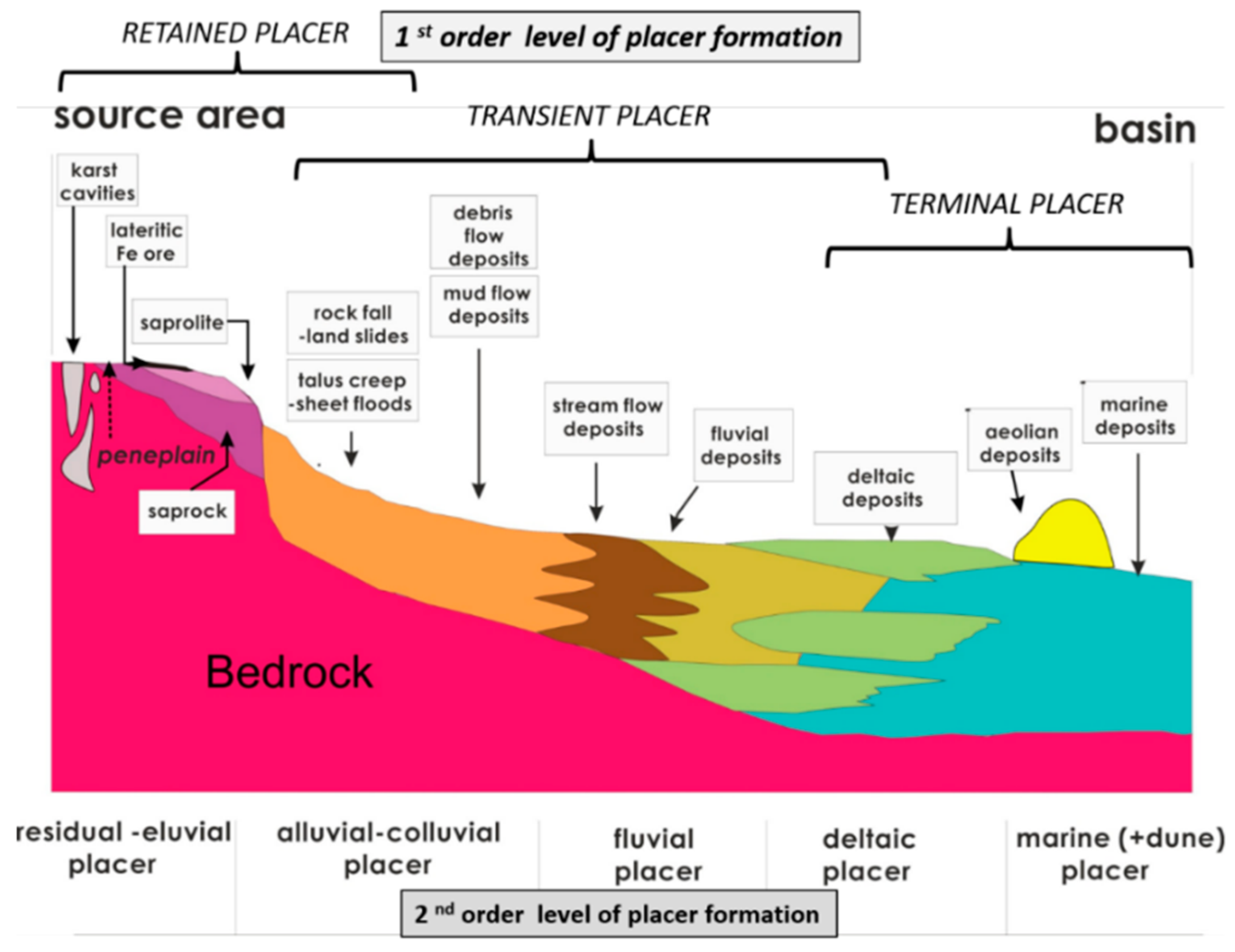
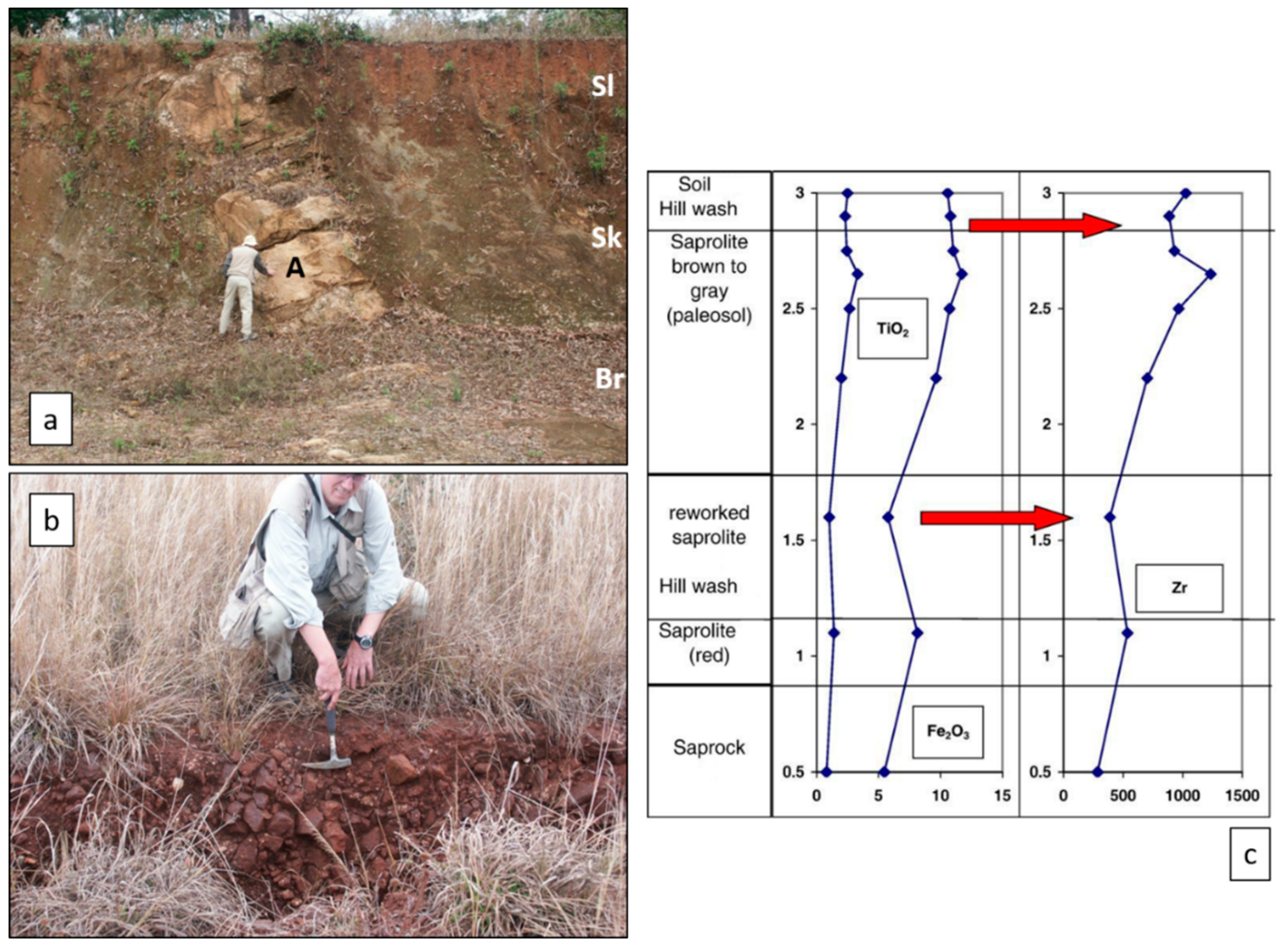
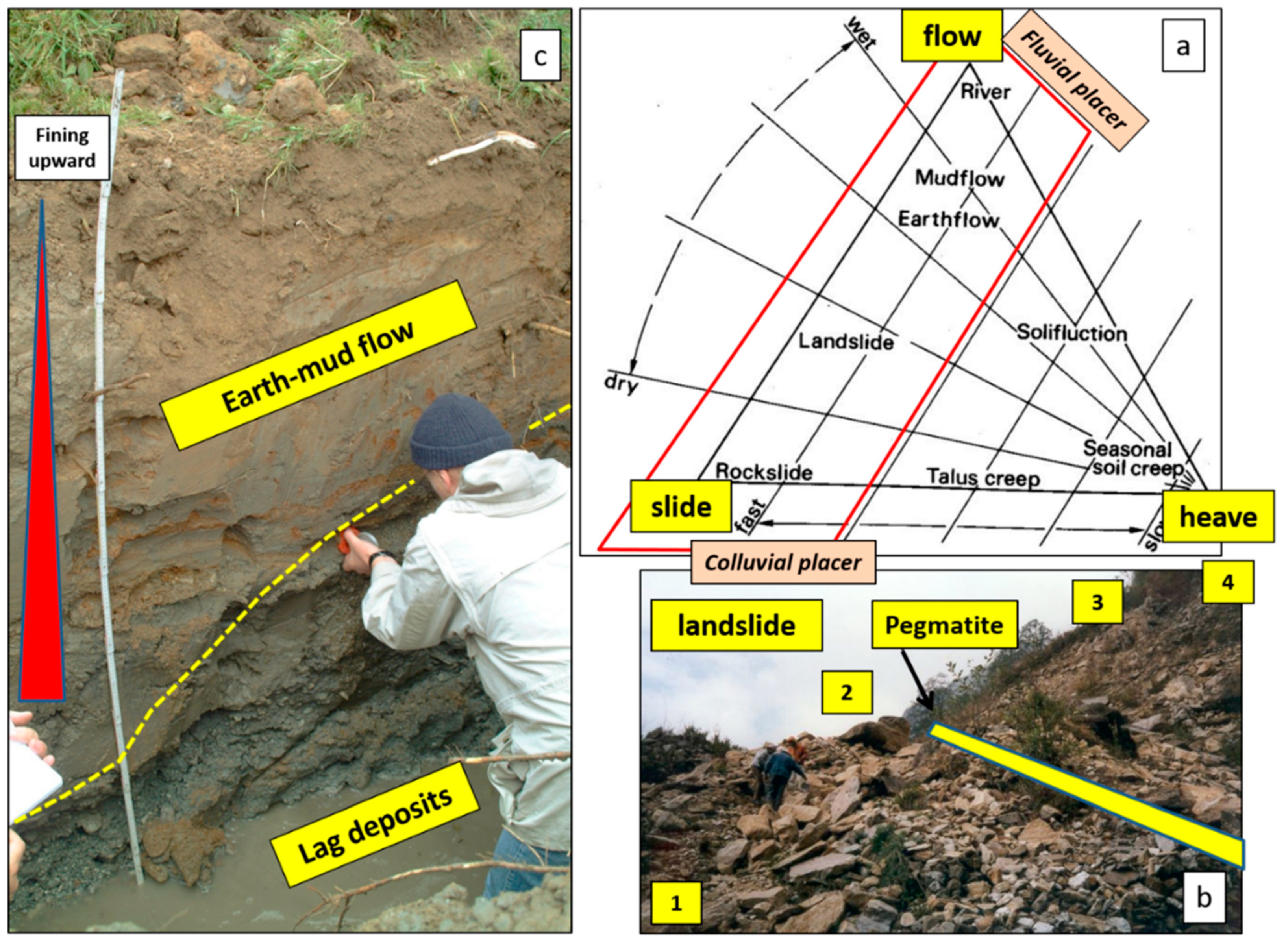
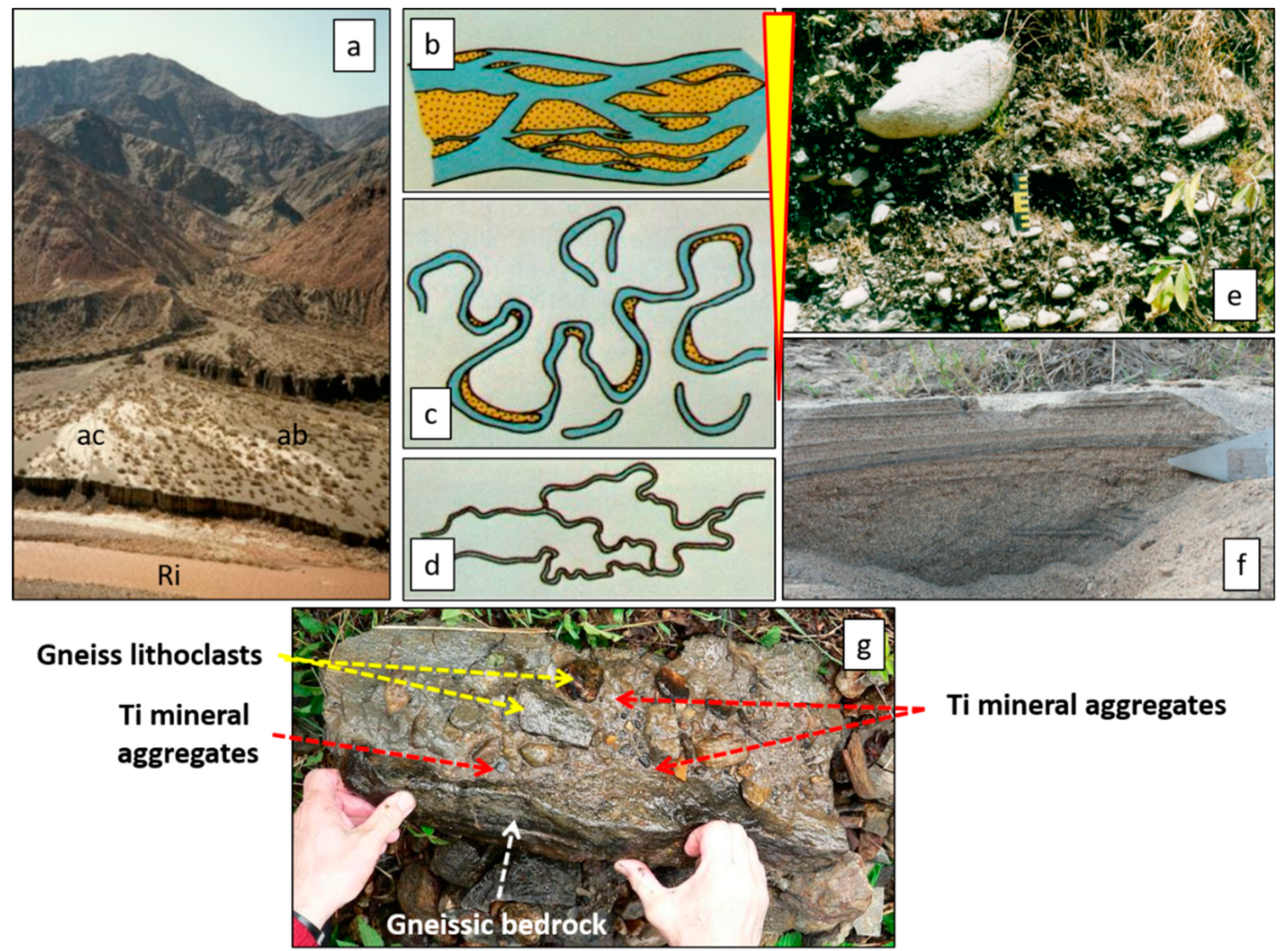
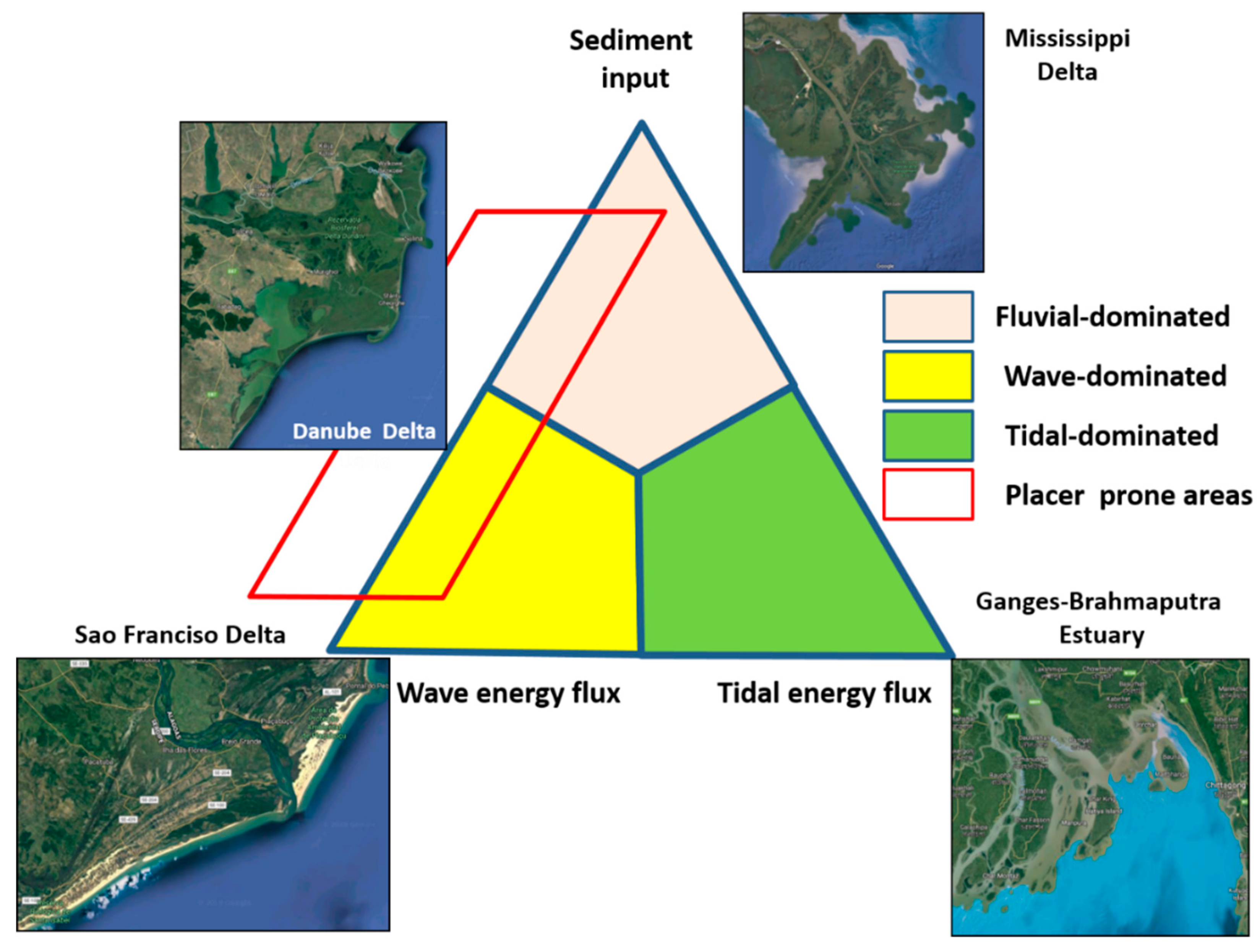
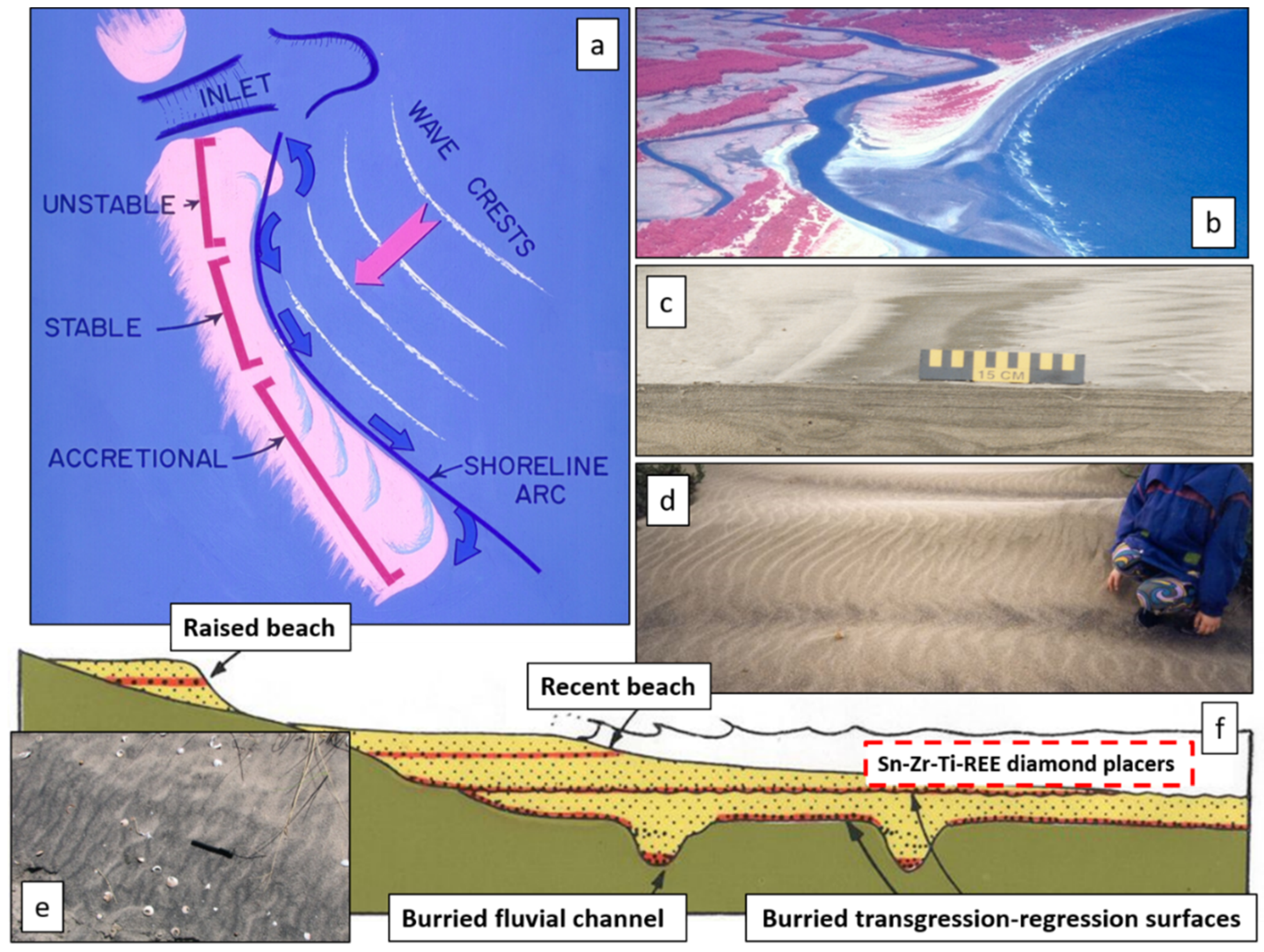
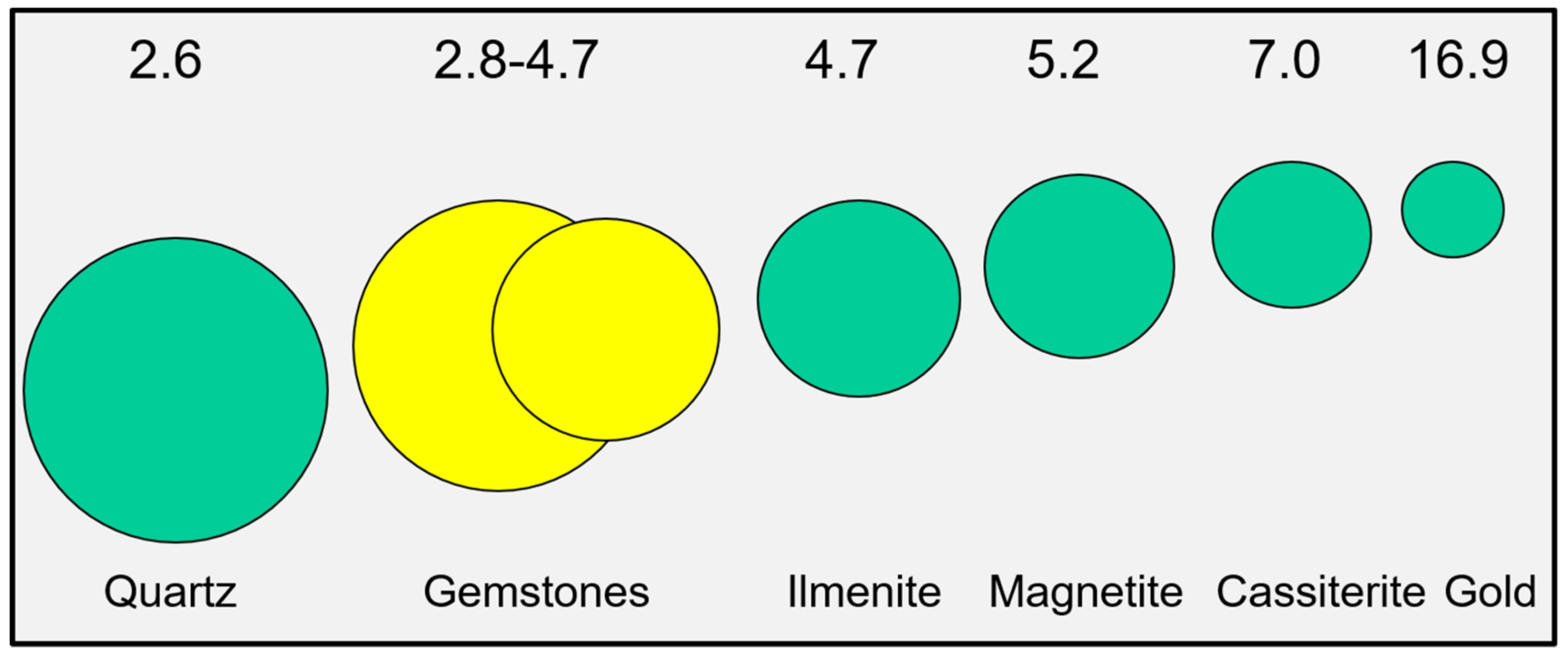
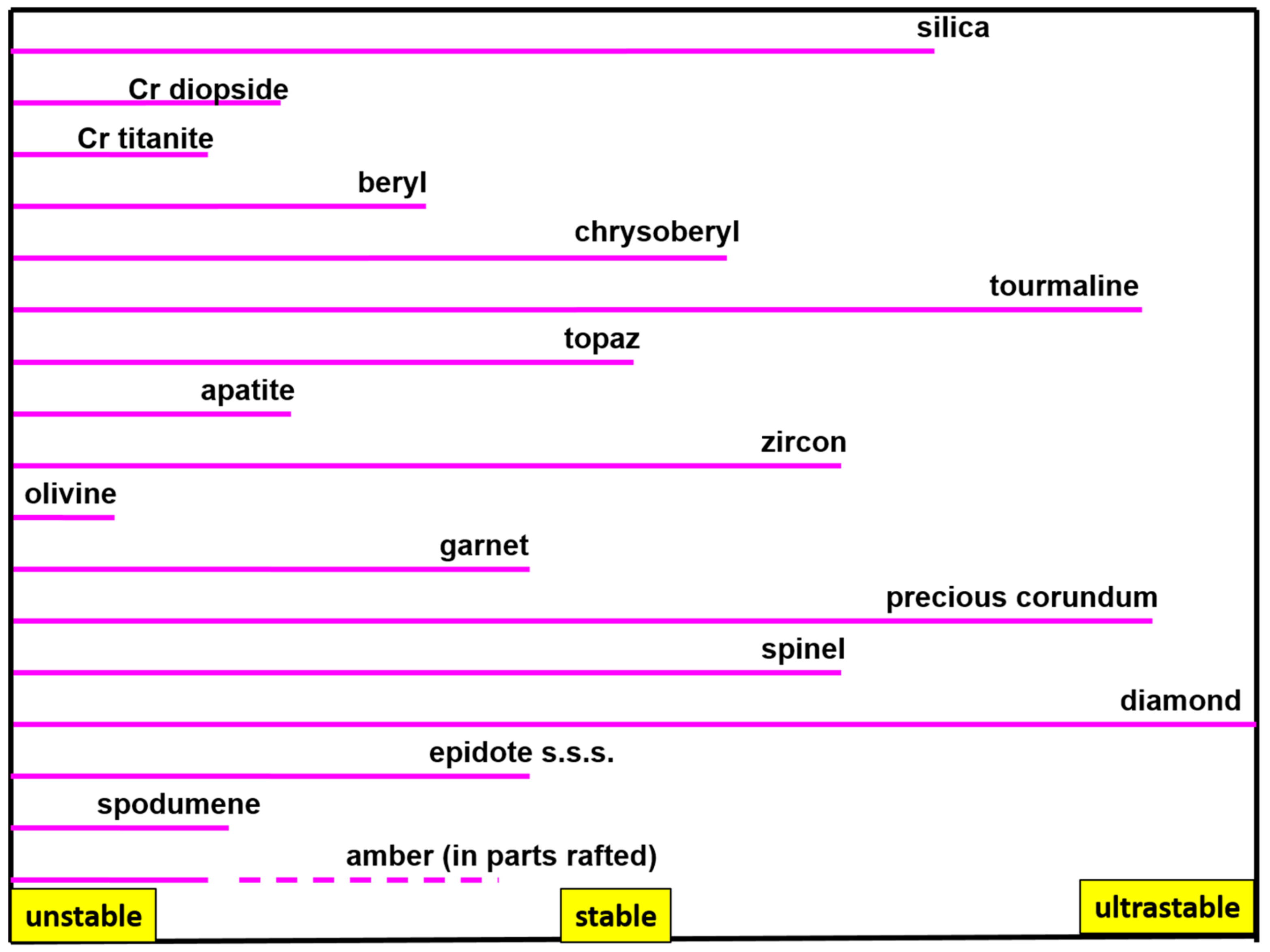
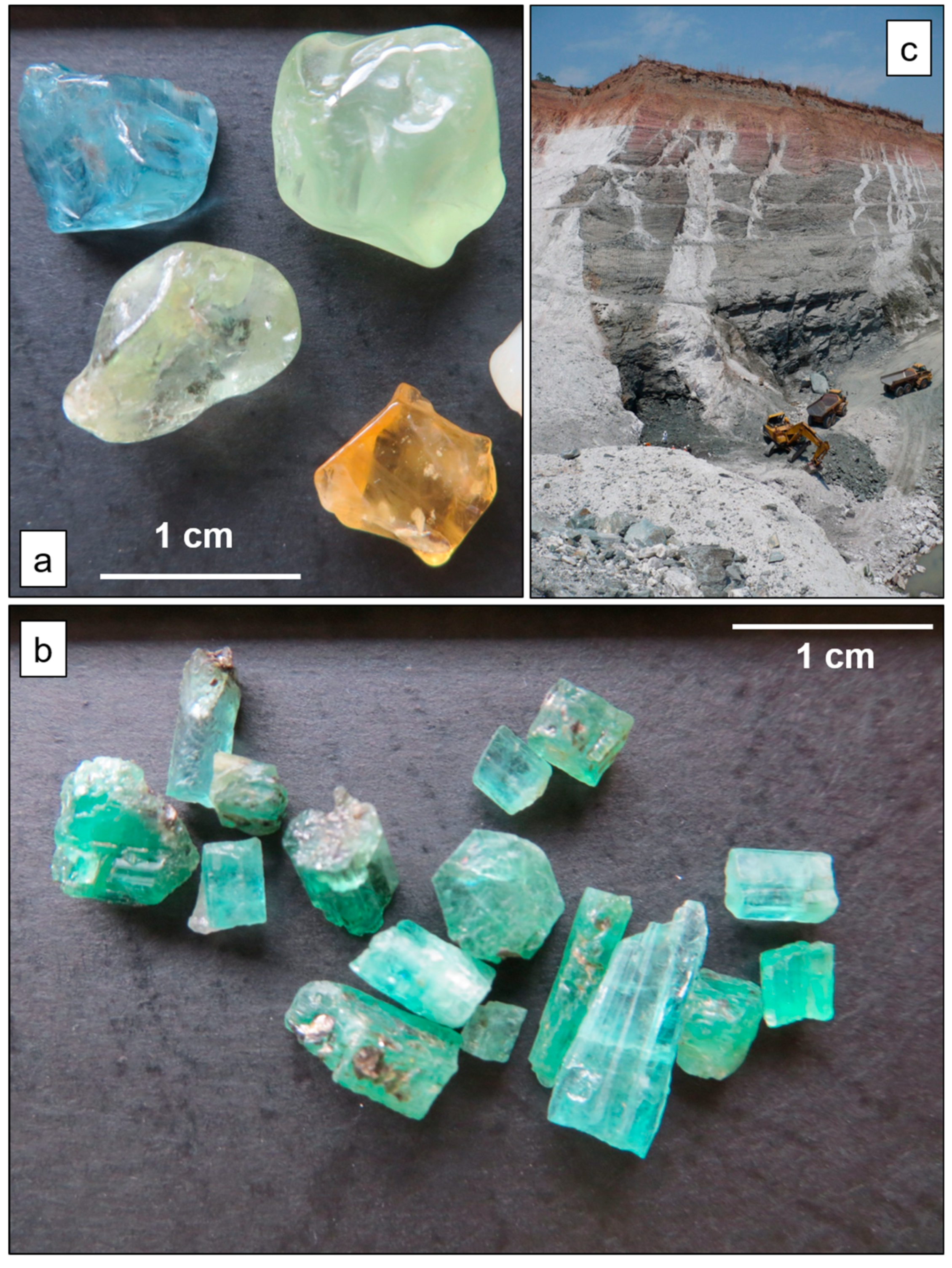
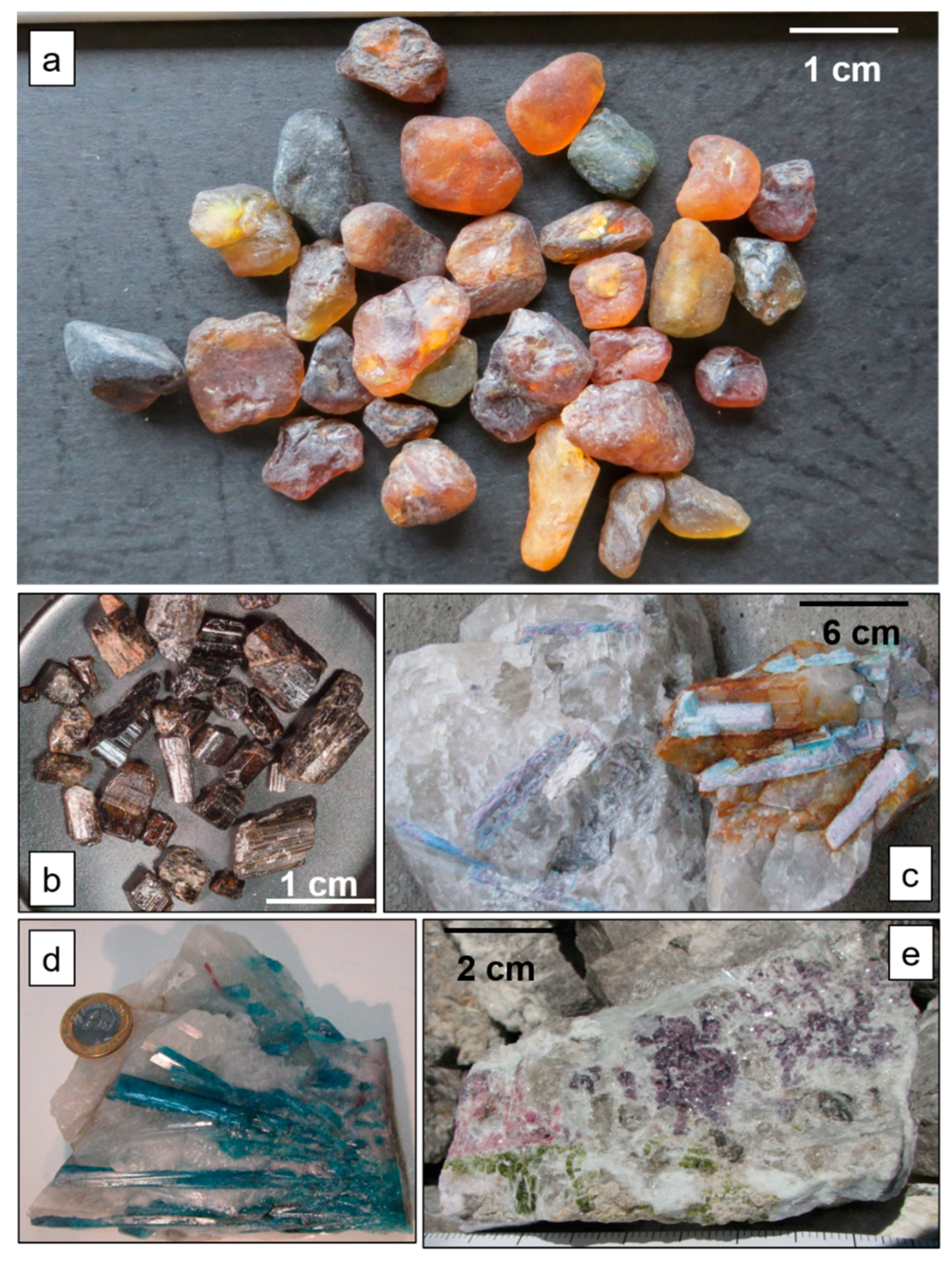
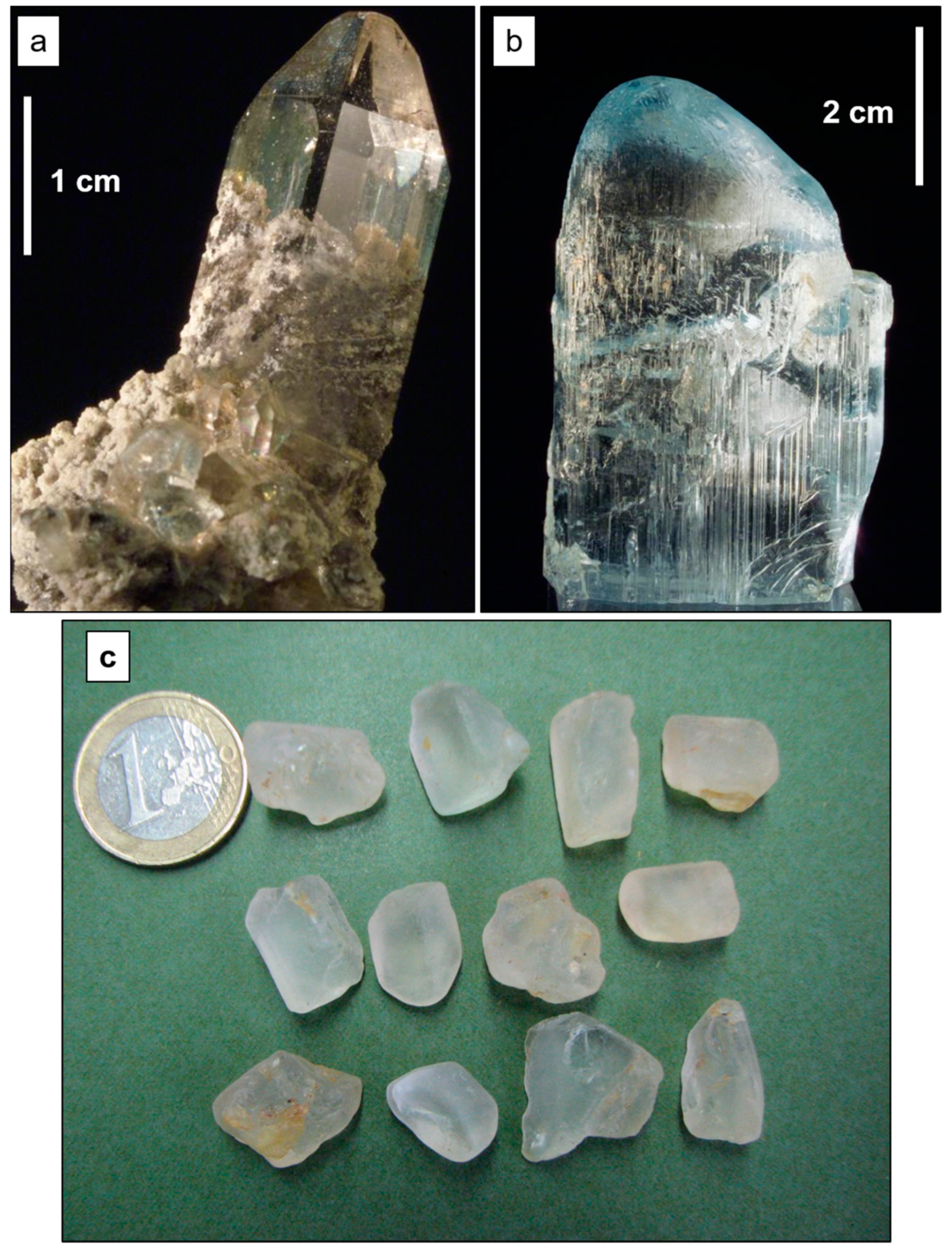
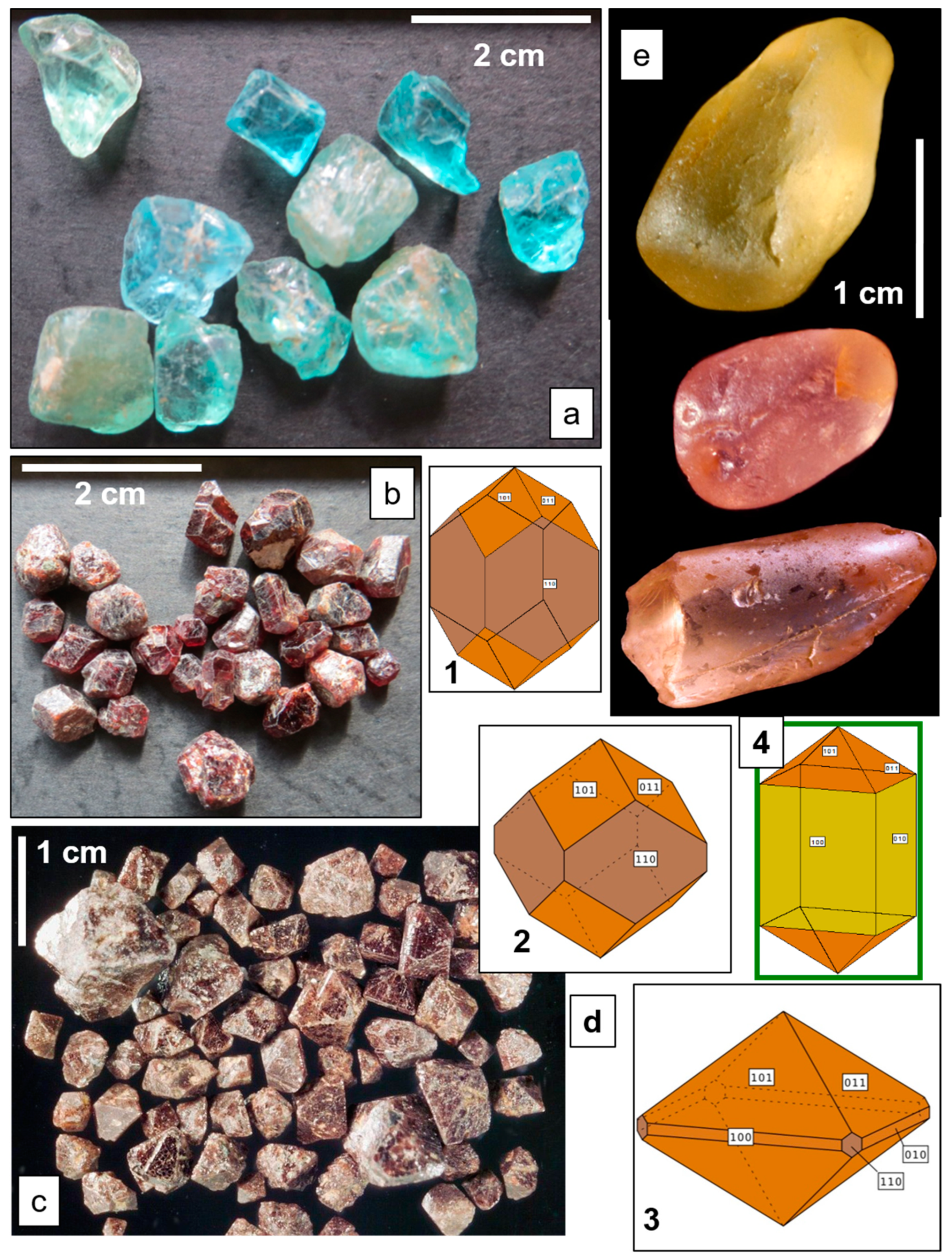
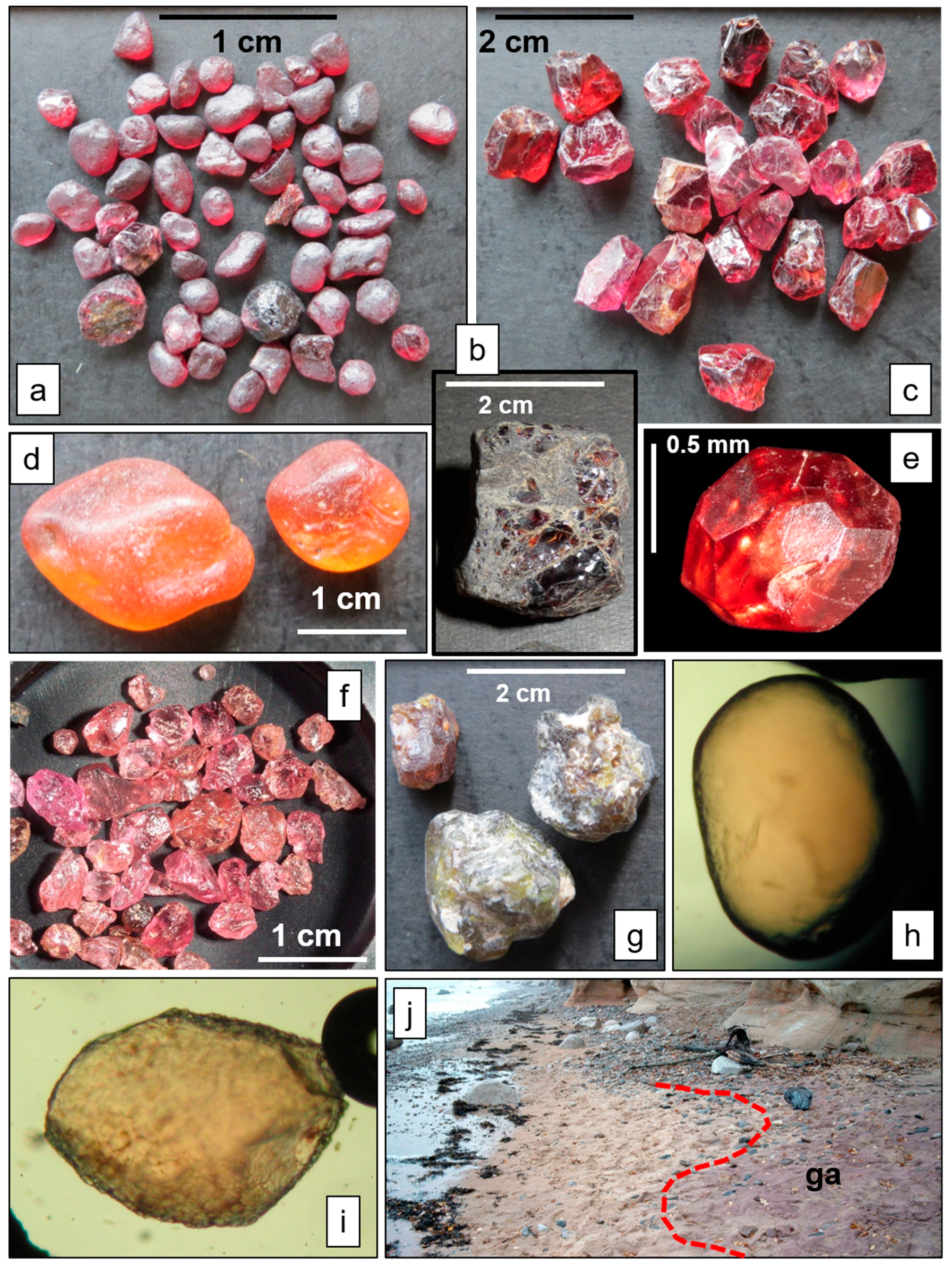
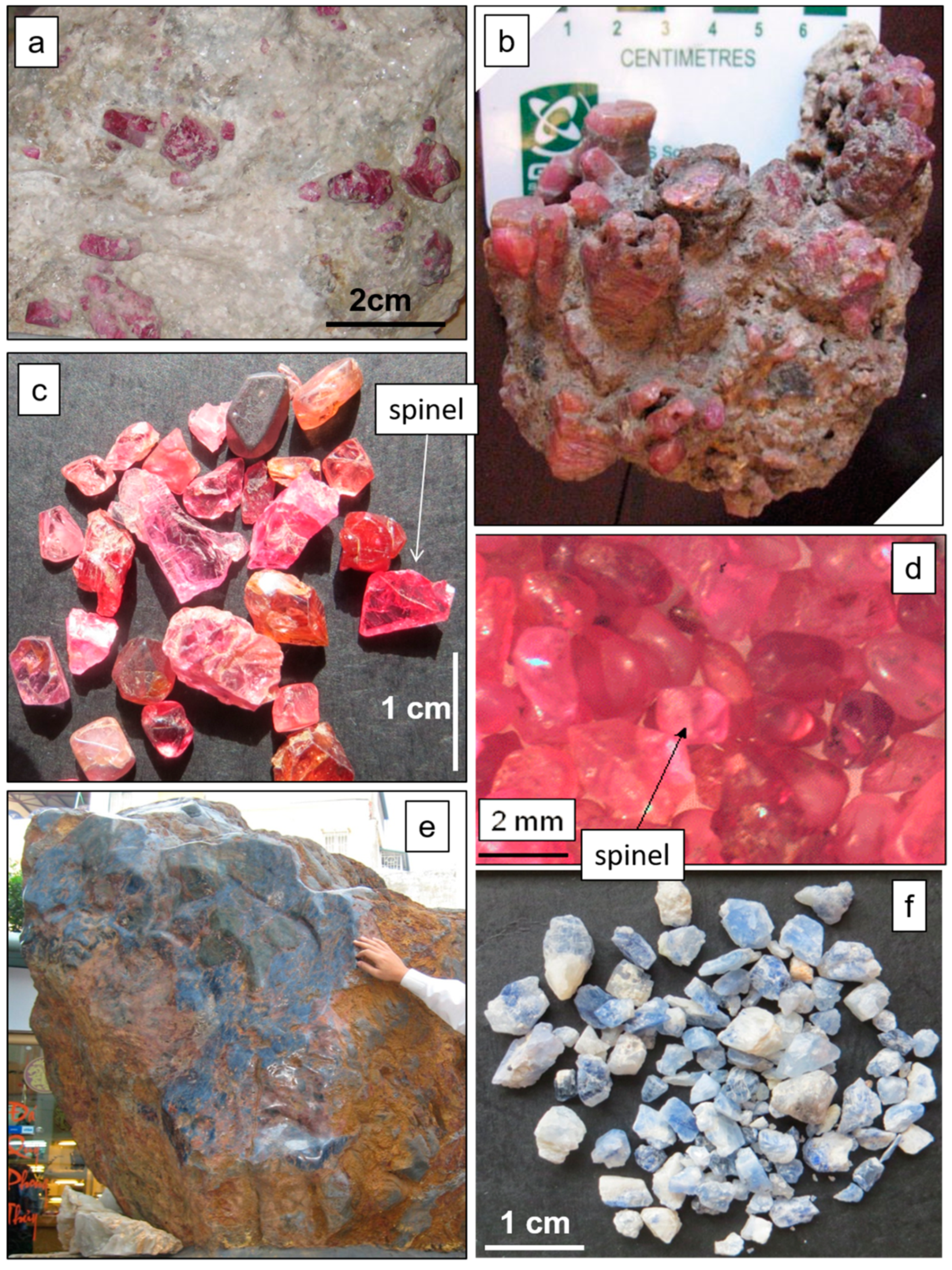

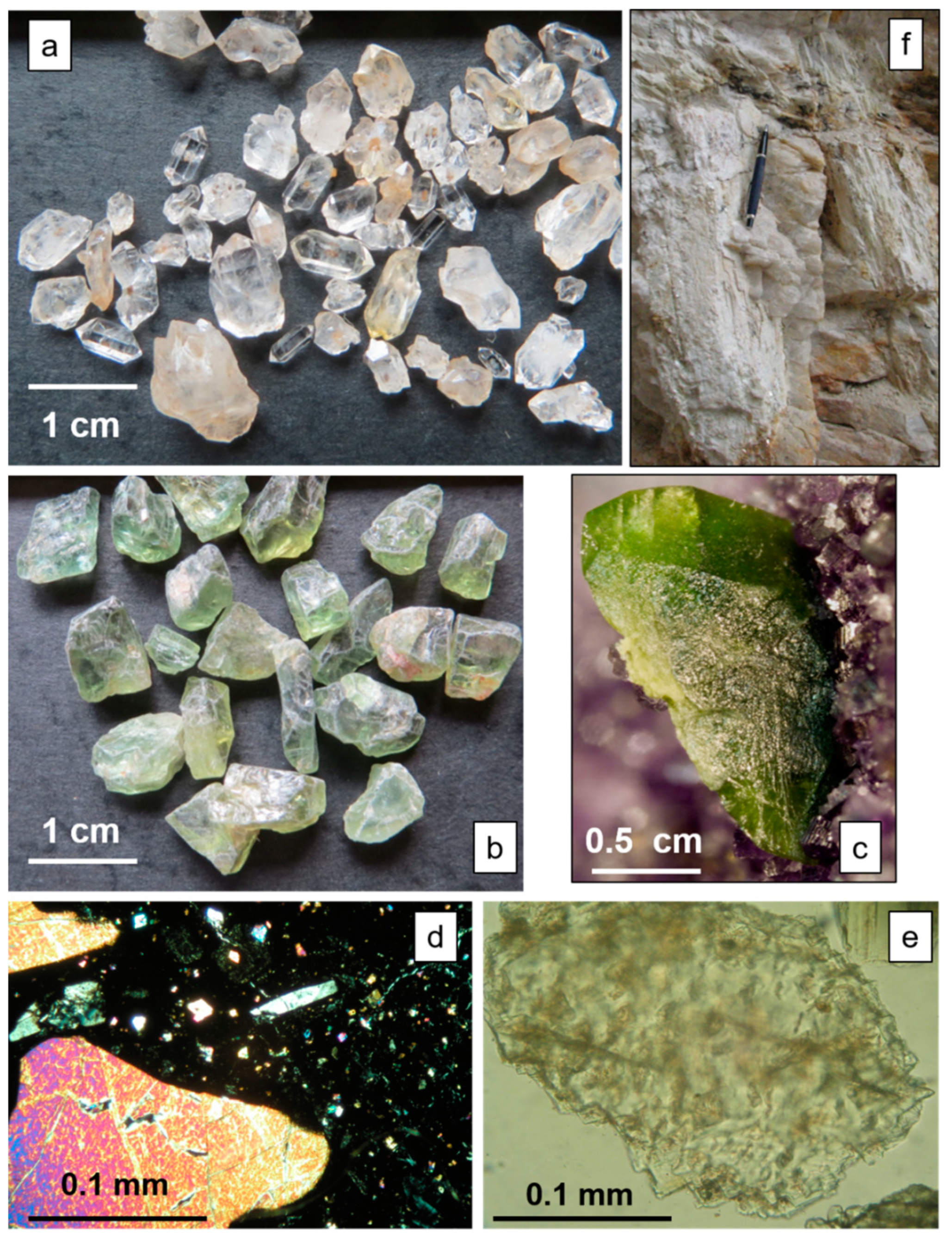
| Element (for General Classification Scheme see [1]) | Mineral | Type | Density (Mean) kg/m3 | Hardness |
|---|---|---|---|---|
| Beryllium | Beryl and its varieties emerald, aquamarine, heliodor, morganite, goshenite, pezzottaite (a) Chrysoberyl (b) | Residual, colluvial, alluvial (fluvial). Argillaceous (kaolin) regolith | (a) 2.8 (b) 3.7 | (a) 7.5–8.0 (b) 8.5 |
| Boron | Tourmaline (further minerals see Table 2) | Residual to colluvial placers in stream sediments and marine placer deposits as byproduct, useful as proximity indicator/pathfinder | 3.2 | 7.5 |
| Fluorine | Topaz | Residual to colluvial placers in stream sediments useful as proximity indicator/pathfinder | 3.6 | 8.0 |
| Phosphorous | Apatite | Eluvial, colluvial, alluvial placers | 3.2 | 5.0 |
| Zirconium | Zircon (hyacinth) | Gemstone: residual to alluvial placers. Industrial minerals: marine placers | 4.7 | 7.5 |
| Garnet group | Grossular (hessonite, tsavorite), spessartine, pyrope and its variety rhodolite, andradite (demantoid), almandine | Gemstone: residual to alluvial placers. Industrial minerals: also in marine placers | 4.2 | 7.0–8.0 |
| Corundum | Ruby, sapphire, padparaja | Residual, eluvial, colluvial alluvial-fluvial | 4.1 | 9.0 |
| Spinel | Spinel group minerals | See corundum | 3.6 | 8.0 |
| Diamonds | Diamond | Residual, eluvial, colluvial, alluvial-fluvial, marine and aeolian modern and paleoplacers deposits | 3.5 | 10 |
| Silica | Rock crystal, agate, amethyst, citrine, quartz, rose quartz, smoky quartz | Alluvial-fluvial placers (amethyst, agate, rock crystal). Residual placer (double terminated rock crystal) | 2.6 | 7.0 |
| Chromium | Cr titanite (a), Cr diopside (b) | Colluvial-alluvial-fluvial placers (Cr diopside), ((Cr)-titanite) short distance of transport, useful as pathfinder | (a) 3.5 (b) 3.4 | (a) 5.0–5.5 (b) 6.0 |
| Olivine s.s.s. | Peridote | Colluvial-alluvial-fluvial-marine placers only in case of a high ratio of uplift/weathering and/or short distance of transport | 3.3 | 6.5–7.0 |
| Epidote s.s.s. | Tanzanite | Colluvial-alluvial | 3.3 | 6.5 |
| Lithium | Kunzite, hiddenite | Residual to alluvial placers, swiftly decomposes to argillaceous material | 3.2 | 6.5–7.0 |
| Organic compounds | Amber | Fluvial, marine placers | 1.1 | 2.0–2.5 |
| Axinite | Ca2MgAl2(BO3)Si4O12(OH) |
| Danburite | CaB2Si2O8 |
| Datolite | CaB(SiO4)(OH) |
| Dravite | NaMg3Al6(BO3)3Si6O18(OH)4 |
| Dumortierite | Al6.9(BO3)(SiO4)3O2.5(OH)0.5 |
| Elbaite | NaLi2.5Al6.5(BO3)3Si6O18(OH)4 |
| Elbaite (Paraiba) | |
| Elbaite (Indicolite) | Na(Li,Al)3Al6(BO3)3Si6O18(OH)4 |
| Jeremejevite | Al6B5O15F2.5(OH)0.5 |
| Kornerupine | Mg3.5Fe2+0.2Al5.7(SiO4)3.7(BO4)0.3O1.2(OH) |
| Painite | Ca0.77Na0.19Al8.8Ti0.19Cr0.03Zr0.04B1.06O18 |
| Elbaite (Rubellite) | Na(Li,Al)3Al6(BO3)3Si6O18(OH)4 |
| Serendibite | Ca2Mg4.5Al1.5Si3.6Al1.8B0. |
| Sinhalite | MgAl(BO4) |
| Environment | Lithoclasts | Heavy Minerals |
|---|---|---|
| Primary deposit | 70% volcanites (olivine basalt, bassanite, trachybasalts), 30% tuffaceous breccia composed mainly of fragments of shales, sandstones, crystalline rocks and volcaniclastic material | olivine, titanite, garnet (pyrope-enriched), garnet (almandine-enriched), zircon, clinozoisite, epidote (pistazite), amphibole |
| Secondary colluvial to alluvial placer deposit | 50% volcanites, 20% tuffaceous breccia, 20% crystalline rocks, 10% olivine-garnet aggregates | titanite, garnet (pyrope-enriched), garnet (almandine-enriched), olivine, zircon green amphibole, brown amphibole, tremolite-actinolite, apatite, epidote (pistazite), clinozoisite, orthopyroxene (bronzite, hypersthene), clinopyroxene, biotite, spinel |
| Fluvial placer deposits (proximal tributary stream) | 20% volcanites, 10% tuffaceous breccia, 30% crystalline rocks, 20% granitic fragments, 20% shales/slates | titanite, green amphibole, brown amphibole, olivine, epidote (pistazite), garnet (almandine-enriched), zircon, apatite, orthopyroxene (bronzite, hypersthene), spinel, andalusite |
| Fluvial placer deposits (intermediate tributary stream) | 20% volcanites, 10% tuffaceous breccia, 30% crystalline rocks, 20% granitic fragments, 20% shales/slates | titanite, green amphibole, brown amphibole, zircon, epidote (pistazite) apatite, garnet (almandine-enriched), monazite, tourmaline, fayalite-enriched olivine, hypersthene, |
| Fluvial placer deposits (distal tributary stream) | 10% volcanites, 5% tuffaceous breccia, 50% crystalline rocks, 10% granitic fragments, 25% shales/slates | titanite, green amphibole, brown amphibole epidote (pistazite), zircon, apatite, garnet (almandine-enriched), (pyrope-enriched), orthite |
| Fluvial placer deposits (trunk river) | 10% volcanites, 60% crystalline rocks, 10% granitic fragments, 20% shales/slates | titanite, green amphibole brown amphibole, epidote (pistazite), garnet (almandine-enriched), (pyrope-enriched), fayalite-enriched olivine, zircon, apatite, forsterite-enriched olivine, hypersthene |
© 2018 by the author. Licensee MDPI, Basel, Switzerland. This article is an open access article distributed under the terms and conditions of the Creative Commons Attribution (CC BY) license (http://creativecommons.org/licenses/by/4.0/).
Share and Cite
Dill, H.G. Gems and Placers—A Genetic Relationship Par Excellence. Minerals 2018, 8, 470. https://doi.org/10.3390/min8100470
Dill HG. Gems and Placers—A Genetic Relationship Par Excellence. Minerals. 2018; 8(10):470. https://doi.org/10.3390/min8100470
Chicago/Turabian StyleDill, Harald G. 2018. "Gems and Placers—A Genetic Relationship Par Excellence" Minerals 8, no. 10: 470. https://doi.org/10.3390/min8100470
APA StyleDill, H. G. (2018). Gems and Placers—A Genetic Relationship Par Excellence. Minerals, 8(10), 470. https://doi.org/10.3390/min8100470




